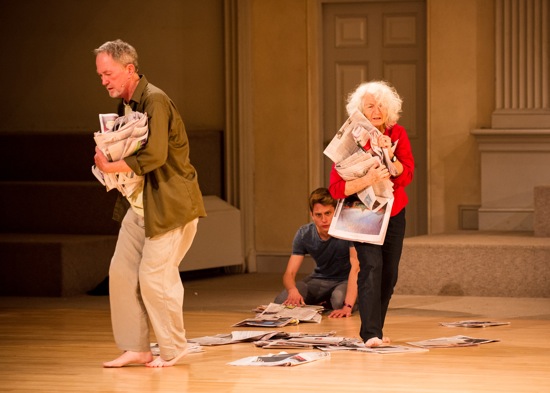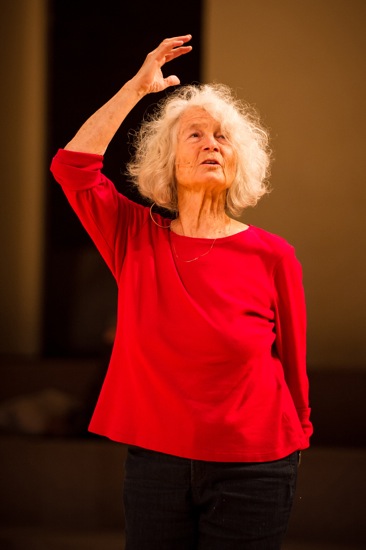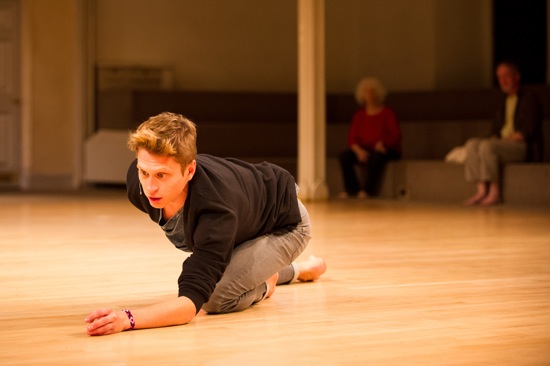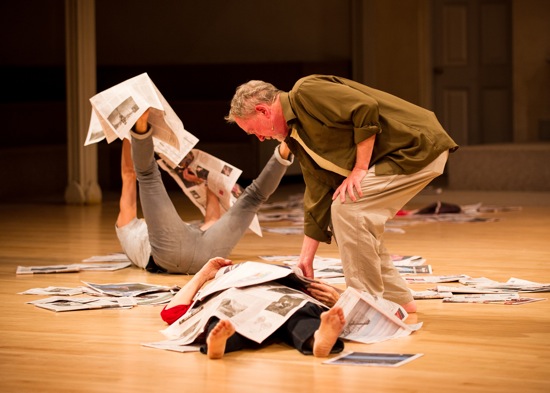
(L to R) Terrence Luke Johnson, Brennan Gerard, and Simone Forti in That Fish Is Broke. Photo: Ian Douglas
Here’s how Simone Forti laid out her 1961 From Instructions: “One man is told that he must lie on the floor during the entire piece. Another is told that he must tie the first man to the wall.” (I like picturing the possibilities inherent in this structured improvisation.) In her wonderful 1974 book, Handbook in Motion, Forti mentions that the room in which From Instructions was first performed had pipes running along the wall and anyone wanting to do it needs to find a space with a similar structure. She’s aware of practicalities.
That particular work was part of Forti’s contributon to a series that composer La Monte Young was engineering in a Chambers Street loft. She called her evening “five dance constructions and some other things.” That Fish Is Broke, which Forti performed with two friends as part of Danspace Saint Mark’s ongoing PLATFORM 2012: Judson Now (November 8 through 10), is separated from her early pieces not just by decades, but by her evolving interests. Unchanged, however, are her directness, her sagacity, her playful imagination, and her wit.
Forti wasn’t part of the historic July 1962 event in Judson Church, whose 50th anniversary Danspace is celebrating—an hours-long performance that can be considered as a graduation exercise for all the choreographers who’d been taking Robert Dunn’s far-out composition course that spring. But she was part of the circle that included Yvonne Rainer, Steve Paxton, Trisha Brown, David Gordon, and others, and her absence in the initial group doesn’t diminish her importance to burgeoning postmodern dance.
Forti preceded the Judsonites into looking at dance slantily. Beginning in 1956, she participated in the radicalizing workshops taught by Anna (then Ann) Halprin near the Northern California coast. She was there when Rainer and Brown arrived in the summer of 1960, and when she moved to New York that fall, she took the composition course that Dunn was teaching at Merce Cunningham’s studio and started making work.
Following her career is a slippery job. She came to New York married to artist Robert Morris (later a member of Judson Dance Theater) and performed as Simone Morris. In 1962, she married artist/theater artist Robert Whitman and appeared on programs as Simone Whitman. But it was under her given name, I believe, that she went to Woodstock in 1969. It may have been there that her adventures in the counter-culture and experiments with hallucinogens sent her deep into bodily awareness and into sensing nature in part through how it made her feel like moving.
Perhaps I’ve stated that inaccurately. She wanted to move in tune with nature, to understand an animal, a stone, the wind. . . through their shapes, impetuses, equilibrium. She became patient.
She shared That Fish Is Broke with Brennan Gerard and Terrence Luke Johnson, and I daresay each of the three improvised evenings at Saint Mark’s differed. However all involved moving and speaking, and although everything that happened was rooted in the performers’ diverse personal experiences, they also wove into the evenings what Forti in a program note called “the flickering, fluid version of the world brought to us by the news media.”
Forti begins the Thursday evening performance alone. She’s a small woman with a sturdy-yet-soft body, an eruption of white hair, and a sweet voice. Her solo sets a kind of rhythm for the evening. It involves watching and waiting, weighing in only when necessary. Also struggling to articulate thoughts and sensations in words and motion and showing that effort. She’s as curious and aware as an animal, as full of wonder and questions as a very smart child. Her gaze and her first gestures delineate and respond to the space—the high vault of St. Mark’s, its u-shaped balcony. She talks about displacement (the three of them flew in from California the week Sandy hit us). She starts moving along a diagonal, shaping air with her hands and body; she’s trying to articulate—to understand—a force like a strong wind. She advances, backs up, tries again. It occurs to her to wonder whether the moon is full everywhere in the world at the same time. Then she moves on to talk about the Hopi tribe members and how they travel in a spiral path.
I can’t adequately convey how subjects evolve in her mind—whether prompted by a word or movement— and how fluidly, yet gropingly and persistently she absorbs and embodies ideas. When she’s finished with something, she sits down with the other spectators and watches. By the way, we’re ranged on three sides of the church’s carpeted platforms, but they’re chairless for these performances. Some people lounge, put their legs up; others sit erect or lean forward.
The two interesting men are also at ease—journeying from a selected topic and following where it leads. Gerard (co-director, with Ryan Kelly, of Moving Theater) has been working with Forti since 2011. He enters crawling on his belly, sliding along like a snake (did Forti’s mention of the Hopi inspire this?). His opening line, “The beaches of New Jersey are fake,” leads him into thoughts about the South Carolina barrier island that he grew up knowing, and a father who was a “storm-watcher,” and from there into words about the Tokyo earthquakes, the lust for money, international financial transactions, and more. All the while he is moving, dredging up his feelings about what he’s saying and allowing the characteristics of his topic of the moment to inform him. He’s taller, more angular, less cushioned on the ground than Forti.
Johnson began working in improvised theater in 1970, and the Ph.D. he acquired in the 1990s is in English literature. He arrives with a bag of books, lays them out, and talks about their authors. He’s especially interested in the collision of two of these men, holding a book in each hand (bring them together and they mate). Growing up in a Swedish Baptist family, he wasn’t allowed to read at the table, but could check out four books a week from the library. Light on his feet, a bit stiff, he keeps stepping back and forth, weaving among the books, bonding the intellectual journey with an actual one. His principal subjects: Carl Schmitt, an influential German political theologian, prominent in the Weimar Republic, who became an ardent Nazi, and the far-left rabbi, Jacob Taubes, who acknowledged a debt to the ideas of the anti-semitic Schmitt.
These are heady ideas to encounter in a dance performance, but it’s impossible not to be as amazed as Johnson that two such different men could share ideas, and discuss together the subject of one of Taubes’s books, Paul’s Epistle to the Romans (chapter 9, verse 12 says “There is no difference between the Jew and the Greek: for the same Lord over all is rich to all that call upon him”). Hear that Romney? How’s that for crossing the aisle?
When the three performers get together, they begin talking and moving on separate tracks, but well aware of one another. I can make out Forti talking about the Times’s Sunday and Thursday “Style” sections and deliciously conflating the paper’s finicky assessments of garments with the current need for people to take warm clothes to people bereft after Sandy. Riffing off the word “wool” and making her body work at explaining about, say, something being too big but WARM (which is what counts), she’s so earnest and anxious to help and so confused by the bustle that you want to run out and say, “take my coat.” When she mentions the possibility of Velcro-ing things together, she sticks onto Gerard, but the word-movement coalitions are rarely that obvious.
Sometimes, the performers eye one another, trying to figure out what’s up. Johnson holds out one side of his shirt like a sail and stands waiting. Forti peruses him, then picks up a pillow and holds it out to the side. This leads to an inscrutable tableau with pillows.
A stack of newspapers sits to one side, and near the end of the evening, Gerard starts to lay them out on the floor in what at first seems an irrational manner, but comes to resemble a straggly path he can move along, picking up paper from behind him and laying it in front. (Is this when Hilary Clinton gets mentioned? God knows her path around the Middle East isn’t an easy one.) In the end, Gerard is using two sheets of paper as skates.
Reading the papers, walking on them, crumpling them, talking, the three develop a heady collage of words that ricochet around, leaping pockets of silence, and actions whose rationale you understand at the time. Golan Heights. Rocks tumbling. People throwing rocks into the Ganges. A cliff fallen near the Hudson. Forti’s hands are moving, turning the paper she holds. “I’m trying to understand the shape of this coastline,” she says—only seemingly out of the blue. She ponders whether, if a woman is carrying a male baby, some of its DNA gets rubbed together with hers. Her entire body ponders this proposition.
Then she looks around the church at us and says, “That’s it.” Oh. Yes.
Note: Danspace has published a fascinating catalogue related to the series, Danspace Project Platform 2012: JudsoNOW (available at the church before and after Danspace events or at https://web.ovationtix.com/



